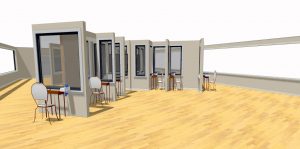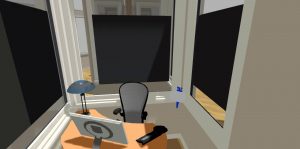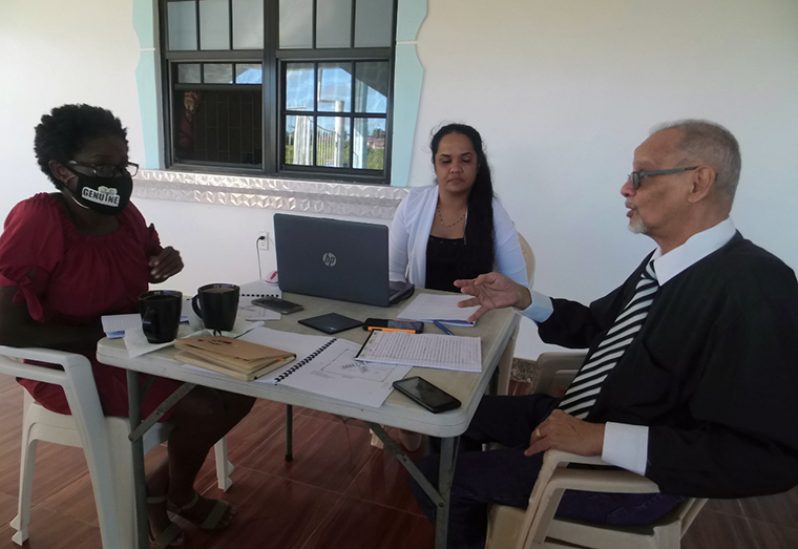— replaces traditional classrooms with creative alternative in light of COVID-19
By Jeune Bailey Van Keric
BERBICE Educators have re-imagined and re-designed a creative alternative to the traditional classroom that would allow for a safe return to in-person teaching and learning.

The design follows all applicable guidelines from the Centre of Disease Control, the National Health Institute and the Ministry of Health. The design does not show the obvious mask-wearing at all times when in school; hand sanitising every two hours: and no mass-gathering, as there is sufficient awareness that these must become part of our regular national habits.
During an interview with Professor Daizal Samad and Ashwannie Harripersaud, an Assistant Senior Mistress at the Canje Secondary School, it was emphasised that online teaching cannot replace in-person teaching.
“It simply cannot. Our job is to make it safer for this pandemic and all the variants of this pandemic. Vaccines, there are no guarantees that it would be effective in the abortion of this virus. But, we need our children to return to schools. Education at all levels.
“With respect to the variables, we have looked at spatial dimensions, student / teacher posture and placement, entry / exit points that are safe; we have looked at transportation as more than 50 per cent of our children use public transportation. There is need for isolation room in the schools for suspected cases and routine hand-washing; mask-wearing will continue to be enforced,” Professor Samad said.
Additionally, the teacher will have a microphone and would be able to modulate the volume so that each student in each wing of the teaching and learning classroom will hear clearly.
‘… Plexiglas, attention alert buttons… educational conventions such as notes of lessons, course outline, syllabi, etc. can be submitted electronically, so, there is as little paper as possible…. There is no possibility of someone coughing with droplets leaving on paper to affect the teacher… and their relatives…. However, let’s don’t forget the excitement we gained when confronted with something new. With each student input, the excitement grows,” professor Samad told this publication.
Since the completion of the design in October 2020, efforts have been made to capture the attention of senior officials, but their busy lives did not garner a response.
MUST BE GUYANESE

“We did contact the CDC in America (North); we got a response. We contacted the Obama Foundation; we got a response. We contacted the Bill Clinton Foundation, and we got a response. But we have agreed that we want it to be a Guyana thing…. When last have we been known for something good, something exceptional?” the former head of the University of Guyana Tain campus asked rhetorically.
He added: “But with the Teaching and Learning Station, it is Guyana’s contribution to the world which is aimed at saving lives… and that is why we have delayed until now… to have this conveyed to all Guyanese and the nations of the world…. I am confident that this design will bring us back to ‘normalcy’.”
Professor Samad and Harripersaud propose to build a prototype of the re-imagined and re-designed Teaching and Learning Station (T&LS) at the University of Guyana, Berbice Campus, which may be the most convenient location.
The T&LS prototype can be ready for show-case viewing in Guyana about one month after a nod is given from the government.
The educators have expressed a willingness to present the prototype to decision- makers and other interested parties in person.
The teaching and learning station, which can be set up at an estimated cost of $1M, has four wings; each wing being 15 feet in length and six feet in width. The length and width of the wings ensure social distancing between students, and between students and teachers. All surfaces are made of ¾ inch plywood, which is strong enough to withstand bracing, leaning, books and other materials.
Each wing accommodates individual ports for five students– two on each side and one at the head of each wing. This would give a total of 20 students per one hour of face-to-face instruction.
The student port replaces the traditional desk/ bench/ chair, while the teacher’s port is centrally located and is six feet by six feet.
SAFETY
The students’ ports are enclosed by nickel-lined acrylic or Plexiglas, high enough to block aerosol and droplet transfer. It also mitigates any potential ricochet factor. The nickel-lined Plexiglas makes for greater stability and permanence.
The teacher port, also enclosed with Plexiglas on all sides, is central. This centrality assures that the teacher is in direct and comfortable line of vision of students on all sides. Again, the height of the Plexiglas inhibits aerosol transference, and the elevation of the teacher port assures that the height of the Plexiglas does not hinder the sound of the teacher’s voice.
Four-sided monitors are placed around the teacher port at a height above that of the average teacher for unhindered viewing by students from all directions. This also ensures that the teacher is in clear view of the students and vice versa.
The monitors are controlled by a central desk-top computer bolted onto the teacher’s desk situated in the teacher’s port. The teacher is equipped with at least two high-capacity flash drives for pre-prepared content, which may also be submitted electronically in place of the old ‘lesson plan’.
According to Professor Samad, the dimensions of the re-imagined teaching and learning stations can be built within the traditional classroom space with student ports being equipped with numbered buzzers should students need to get the attention of the teacher. Each student and teacher port is also equipped with built-in hand-sanitising wells, and there are discrete entry and exit points for students.
Teachers have a separate entry/ exit route since the teacher port is enclosed and secured and may need to be unlocked, as it assures social-distancing between teacher and the students. Further, the teacher’s port is equipped with a desk, computer and keyboard, a comfortable swivel chair, and equipped with an application to alert the teacher as to which student needs his/her attention for questions / comments.
It is projected that one of the learning stations can serve up to 20 students at any one time. However, with staggered classes, the stations can be used safely and effectively for the entire school day, after sanitising all surfaces after each class.
It must be reminded that the re-imagined and re-designed teaching and learning station is a permanent feature not only against COVID– 19, but against future pandemics.
BEYOND CLASSROOMS
It would also be useful to note that the station can be adapted for boardrooms, conference rooms, staff rooms, university and college rooms etc.
Since the onset of the coronavirus pandemic in March 2020, face-to-face teaching has been drastically reduced locally with classes limited to only Grade Six pupils at the primary schools, and the Fourth to Sixth formers at the secondary schools.
While the impact has been felt in all sectors of education, many great experts are at a loss as to how to ensure the health and well-being of students and teachers are maintained. The traditional classroom does not, nor cannot, ensure that all the necessary safety measures are implemented.
The COVID-19 virus has already killed 170 persons locally. As of January 22, 2021, some 7,143 persons have been infected with the virus; some 3,084 cases are from Region Four alone.
A few countries, such as the Scandinavian block, with the exception of Sweden, South Korea, New Zealand, Taiwan and Canada, have acted swiftly to contain and mitigate the virus since it became known in December 2019. Most other countries ignored the facts and warnings, took no action and continue to pay a heavy price with the loss of lives and significant slowing down of their economies.
No sector in any society anywhere is exempt and the education systems have been severely affected and still face some constraints with access to online learning.
“But teachers, from nursery to university level, must be aware of even basic things: do all students have cell phones or computers? Do they all have connectivity? Can they afford it? Do they have electricity? If, as a teacher, one establishes deadlines, can one be assured that the Network is consistently reliable? Children at the nursery level, for instance, learn differently from those in secondary schools , and the former, are much less acquainted with the use of technology. Partial on-line instruction may apply to senior secondary school children and tertiary students. But what of the differently-abled children?” professor Samad asked.
The T&LS is designed to benefit all levels and abilities of learners, pupils and students, he said.



.jpg)








